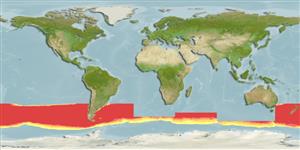>
Lampriformes (Velifers, tube-eyes and ribbonfishes) >
Lampridae (Opahs)
Etymology: Lampris: Greek, lampros = light (Ref. 45335).
Environment: milieu / climate zone / depth range / distribution range
Ökologie
seewasser; tiefenbereich 50 - 485 m. Temperate; 34°S - 69°S
Circumglobal in the southern hemisphere between 34°S and the Antarctic Polar Front.
Size / Gewicht / Alter
Maturity: Lm ? range ? - ? cm
Max length : 110 cm TL Männchen/unbestimmt; (Ref. 6475); max. veröff. Gewicht: 30.0 kg (Ref. )
Rückenflossenstacheln (insgesamt) : 0; Rückenflossenweichstrahlen (insgesamt) : 55 - 56; Afterflossenstacheln: 0; Afterflossenweichstrahlen: 36 - 40.
Feeds on krill, squid and fishes.
Life cycle and mating behavior
Geschlechtsreife | Fortpflanzung | Ablaichen | Eier | Fecundity | Larven
Gon, O., 1990. Lampridae. p. 215-217. In O. Gon and P.C. Heemstra (eds.) Fishes of the Southern Ocean. J.L.B. Smith Institute of Ichthyology, Grahamstown, South Africa. (Ref. 5188)
IUCN Rote Liste Status (Ref. 130435)
Bedrohung für Menschen
Harmless
Nutzung durch Menschen
Tools
Zusatzinformationen
Download XML
Internet Quellen
Estimates based on models
Preferred temperature (Ref.
123201): 1.8 - 11.9, mean 6.1 °C (based on 287 cells).
Phylogenetic diversity index (Ref.
82804): PD
50 = 1.0000 [Uniqueness, from 0.5 = low to 2.0 = high].
Bayesian length-weight: a=0.01995 (0.00906 - 0.04395), b=3.01 (2.83 - 3.19), in cm total length, based on all LWR estimates for this body shape (Ref.
93245).
Trophic level (Ref.
69278): 4.4 ±0.70 se; based on food items.
Widerstandsfähigkeit (Ref.
120179): mittel, Verdopplung der Population dauert 1,4 - 4,4 Jahre. (Preliminary K or Fecundity.).
Fishing Vulnerability (Ref.
59153): High to very high vulnerability (66 of 100).
Climate Vulnerability (Ref.
125649): Moderate to high vulnerability (45 of 100).
Nutrients (Ref.
124155): Calcium = 17 [8, 32] mg/100g; Iron = 0.355 [0.199, 0.637] mg/100g; Protein = 21 [17, 24] %; Omega3 = 0.636 [0.334, 1.270] g/100g; Selenium = 17.9 [8.9, 35.6] μg/100g; VitaminA = 12 [3, 54] μg/100g; Zinc = 0.322 [0.219, 0.489] mg/100g (wet weight);
